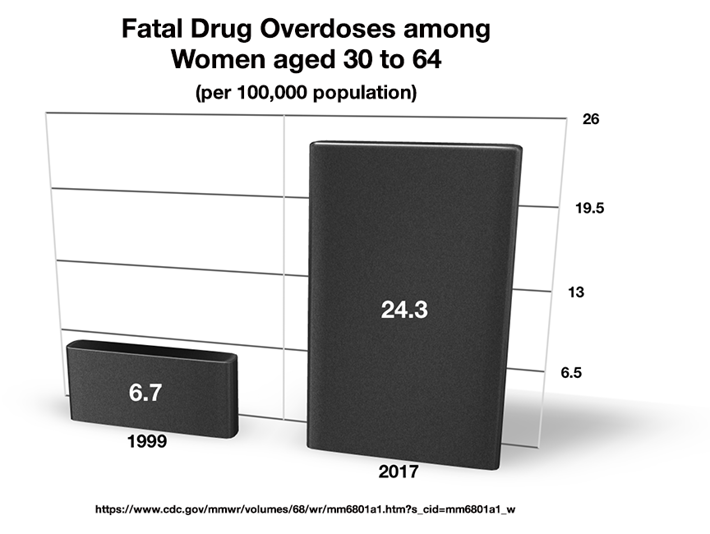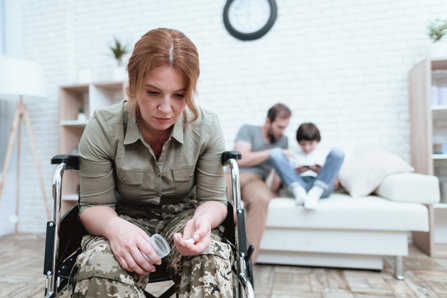2019: Caring for Women Must Include Reversing Losses to Overdoses

Every year, people in Austria, Denmark, Germany, Switzerland, the United States and other countries come together to celebrate International Women’s Day. Governments and corporate sponsors alike contribute to a unifying message on behalf of women everywhere. This year, that message is #BalanceisBetter. The message supports balance in hiring, promoting or paying women employees, in providing women with equal media coverage and in protecting them with fair legislation.
Balance is an important keynote in women’s affairs everywhere. Balance helps keep us all healthy, prevents undue stress and checks human rights violations.
This year’s International Women’s Day gives us an opportunity to examine a new, deadly problem facing women: Rapidly increasing deaths from drug overdoses.
Overdose Losses Rocketing since 1999
Up until the last two decades, far more men lost their lives to drug overdoses than women. Now, women are catching up to men far too fast.
Imagine this: In 1999, for every 100,000 women in America, 6.7 women died from a drug overdose.
But in 2017, that number had rocketed to 24.3 women. That’s a 260% increase.

The age range of women seeing the largest increases in drug overdose deaths are aged 55 to 64.
Why are these older women seeing the biggest increases? A comprehensive analysis doesn’t exist yet but here’s some possibilities:
- The most obvious problems with drugs and addiction are among young adults. Doctors and the families of older women may miss the signs of addiction.
- One study estimated that 50% of older adults suffer from daily pain which very often results in doctors prescribing opioid pain relievers which could lead to dependence or overdoses.
- Older adults may not have the same ability as young people to break down and eliminate painkillers from their bodies. Levels of opioids in their blood could more easily build up to toxic levels.
- A person’s older years may more often be associated with accumulated trauma, loss of loved ones to death, isolation and disability. The effects of opioids may ease the emotional reactions to these problems and thus the patient may begin to rely on them for psychological reasons. Even if they are no longer in pain, older women may continue to rely on these pills to let them forget their troubles. They may convince their medical practitioners that these pills are still needed.
Women More Likely to Be on Multiple Prescribed Drugs

A recent study of a large group of female veterans provided another look at the special problems that could affect women. In a 2017 study of 420,000 female veterans, 46% (195,000) were found to suffer from chronic pain. Of these women, four out of every ten women (approximately 78,000) were being prescribed opioids. To make matters much worse, 24% of these women were also being prescribed sedative-hypnotics like Valium or Xanax. The overdose risk of this opioid-sedative combination is much higher than the risk of opioids alone because both drugs suppress the body’s breathing. Alcohol suppresses it even more.
When researchers took a closer look at the female veterans who had already experienced menopause, these women were even more likely to have been diagnosed with chronic pain, be taking opioids long-term, and also taking the combination of opioids and sedatives.
Another study comparing men and women diagnosed with chronic pain who take opioid painkillers revealed that more women than men were likely to be on multiple medications, They were therefore at higher risk of adverse drug interactions and overdose. This study noted that between 1999 and 2012, toxic reactions tripled among women, and opioid-related poisoning hospitalizations increased for women, but not for men.
What to Watch For
Close monitoring can help you protect a female family member of any age from falling into dependence on opioids.
Here’s signs to watch for:
- Is your loved one getting pain relievers from more than one doctor? Check pill bottles for prescribers’ names.
- Monitor their ability to think clearly and their stability on their feet.
- If they run out of pills, do they suffer severe flu-like symptoms?
- Do they argue with you if you suggest seeing the doctor to stop taking the pills?
- Do they have accidents around the house or in the car?
- Do they seem drowsy?
These could be signs of dependence on their painkillers. They can also be signs of other mental or physical problems. Only their doctor can determine the cause.
One study revealed that women were far more likely than men to have received prescriptions from five or more practitioners in the prior year. It’s possible that none of these practitioners know anything about the others unless they are in a state that requires a prescriber to check the patient’s name in a state-wide database. Nearly every state provides doctors, nurses and other prescribers with access to a database that informs them of prescriptions handed out to their patients. But in many states, checking this database before prescribing is voluntary, not mandatory. Offices with poor policy compliance may not bother to check, so they may not learn that a patient is receiving painkillers from three or four doctors.

Among those looking for drug rehab services after abusing opioids, women were much more likely than men to have received their opioids from a medical practitioner than, say, a drug dealer. A single patient could receive opioids from dentists, nurse practitioners, internists, orthopedic surgeons, general practitioners, neurologists, kidney specialists (nephrologists), and urologists, among other professionals. Be alert to who is treating your loved one—especially an older family member or friend who may not have anyone else at home to monitor their care.
What to Do
If you are concerned about an older parent or other loved one who may be consuming too many opioids or other medications, here’s some steps you can take:
- Count their pills from time to time so you can see if they are disappearing faster than they should.
- If your loved one is seeing more than one type of practitioner, you may want to monitor the prescriptions being received and filled from each one. If you have a medical power of attorney from the patient, you may choose to contact the practitioner directly. Each pill bottle will have the name of the prescriber.
- If your loved one has cognitive problems, you may want to set out only those pills they should take each day so they don’t get confused and take too many or too few. Keep the others locked up.
- Ensure any medications that are no longer needed are disposed of in drug drop-off boxes in pharmacies or police stations.
- Monitor your loved one’s mental clarity and functionality. If they become impaired, contact their primary doctor as soon as possible.
- If you accompany this family member to a doctor’s visit, make sure you bring along every medication, prescription or over-the-counter that person is taking.
- If you have any suspicions about undue reliance on medications or that they might be taking too many medications, check on that person frequently. Call them daily and see them as often as you can so you can detect any change.
In Honor of Women
Women are protectors of our future. They deserve support as they nurture babies in the womb or in their arms. Those children benefit when their mothers are protected from abuses or dangers. Older women are needed as caring grandmothers and advisors to their adult children. Their efforts are needed to benefit their children, neighbors and communities.
There is every reason to single out women for respect and protection and that extends to ensuring women of every age are shielded from becoming dependent on opioid painkillers.


 ®
®